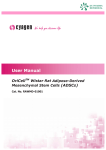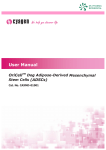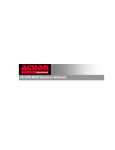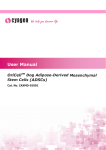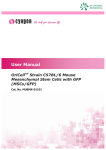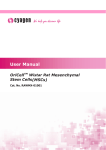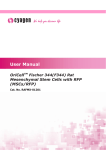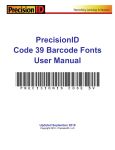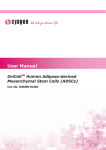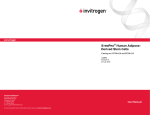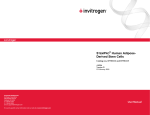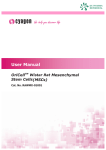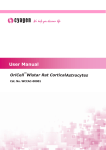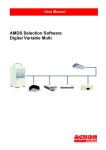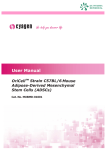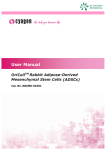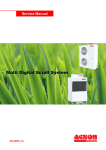Download User Manual - Cyagen Biosciences
Transcript
User Manual OriCellTM Wistar Rat Adipose-Derived Mesenchymal Stem Cells (ADSCs) Cat. No. RAWMD-01001 Table of Contents Contents and Storage ……………………………………………………………………………………… 3 Product Introduction………………………………………………………………………………………… 3 Cell Characteristics and Identity ………………………………………………………………………… 3 Product Applications ……………………………………………………………………………………… 4 General Handling Principles ……………………………………………………………………………… 4 Culturing OriCellTM Wistar Rat ADSCs Thawing and Establishing OriCellTM Wistar Rat ADSCs ………………………………………… 4 Passaging Cyagen OriCellTM Wistar Rat ADSCs …………………………………………………… 6 Differentiation of OriCellTM Wistar Rat ADSCs ……………………………………………………… 8 Cryopreservation of OriCellTM Wistar Rat ADSCs ………………………………………………… 11 Appendix ………………………………………………………………………………… 13 Troubleshooting ……………………………………………………………………………………………… 13 Related Products ……………………………………………….……………….………………………… 14 References ……………………………………………………………………………………………… 14 CONTENTS AND STORAGE Product Name Wistar Rat Adipose‐derived Mesenchymal Stem Cells Catalog No. RAWMD‐01001 Amount per Vial 1×106 Cells Cryopreserved At Second Passage Storage Condition Liquid Nitrogen CAUTION: Please handle this product as a potentially biohazardous material. This product contains Dimethyl Sulfoxide (DMSO), a hazardous material, in the freezing medium. PRODUCT INTRODUCTION Adipose-Derived Mesenchymal stem cells (ADSCs) are multipotent stem cells that can differentiate into a variety of cell types including osteocytes, adipocytes, and chondrocytes. ADSCs proliferate quickly and are capable of generating a local immunosuppressive microenvironment, thus contributing to their wide application potentials in tissue engineering, cell therapy, and gene therapy. OriCellTM Wistar Rat Adipose-Derived Mesenchymal Stem Cells are derived from the adipose tissue at inguen of qualified Wistar Rats. These cells have a strong capacity for self-renewal while maintaining their multipotency. In addition, these cells have been tested for: • Exogenous Factors: bacterial/fungal contamination, mycoplasma contamination, and endotoxin contamination. • Characteristics: post-thaw viability, cell cycle, verification of undifferentiated state, and differentiation potential. This product is intended for laboratory research use only. It is not intended for diagnostic, therapeutic, clinical, household, or any other applications. CELL CHARACTERISTICS AND IDENTITY • Strong capacity to expand. Can be passaged at least 3 times. • Multipotent differentiation ability along the osteogenic, chondrogenic, and IMPI0056A3 RAWMD‐01001 Page 3 of 14 adipo ogenic linea ages. • Positiive for CD4 44, CD90 an nd CD29 (> > 70%), and negative for CD34, CD11b and d CD45 5 (< 5%) in n flow cytom metry assay ys. PRODUC CT APPL LICATIO ONS AD DSCs have become a popular ressearch targ get due to their t potenttial use in re egenerative e medicine and a tissue engineering (in areas such as ca ardiovascula ar, neural, an nd orthoped dic disease). star Rat AD DSCs can be e used as cell models to evaluate e the immu unoreactions, OriCellTM Wis n of ADSCs both in viv vo and in vitro. v prroliferation,, immigration, and diffferentiation GENERA AL HAND DLING PRINCIP P PLES 1. Aseptic handling h of the producct is necess sary throughout. 2. TM Once the e cells have e been esta blished, alw ways freeze e up severa al vials of OriCell O Wistar Ra at ADSCs as a a backup p. Note: The O OriCellTM WI ISTAR RAT ADSCs can be frozen/ /thawed att least one times. t N nance of ce ells, we reco ommend th he seeding density to be 1.53.. For general mainten 2 c . 2.0×104cells/cm 4.. For all studies, it is strongly re ecommende ed to use ce ells that are e at, or und der, an p number of 10 0. original passage 5.. For generral maintena ance of cellss, we recom mmend that the medium m is change ed if it becomes acidic (the pH indicato or in medium m appears yellow). y In general, change the growth medium m everry three day ys. 6.. Do not lett OriCellTM Wistar W Rat A ADSCs overg grow as it will w result in contact inh hibition. When the e cells are 80-90% conffluent, subc culturing the e cells is strrongly recom mmended. No ote: We strrongly recommend the e use of OriCellTM cultu ure media a and other related r re eagents for optimal re esults. THAWIN NG AND D ESTABLISHIN G OriCe ellTM WIS STAR RA AT ADSC Cs M Materials Required R • OriCellTM Rat Adipos se-Derived Stem Cell Growth Me edium (Cat.. No. RAXM MD-90011) • 0.1% Gelatin Solution (Cat. No o. GLT-113 301) Ge elatin Coating of Tissue T Cu ulture Ves ssels IMPI0056A3 RA AWMD‐01001 Page 4 of 14 4 1.. Add sufficient Gelatin Solution into the cu ulture vesse el to complletely coverr its base. 2.. Swirl unttil Gelatin Solution S coa ats the entire base of vessel. Lett it sit for att least 30 minutes at a room tem mperature.. 3.. Aspirate off all of th he Gelatin S Solution and allow the e residual a mount to evaporate e ng the vesse el sitting op pen in the laminar l flow w hood/bio ological safe ety cabinet by leavin for no mo ore than 30 0 minutes. 4.. Enclose the t culture vessel once e it has dried. Note: Gelattinized dis shes or flas e stored at 4°C for n no more th han 2 sks can be w weeks, prov vided they y remain s sterile. Th hawing and Establishing W Wistar Ratt ADSCs m the fully supplemen s ted (complete) OriCelllTM Rat ADS SC Growth Medium to o 1.. Pre-warm 37°C. 2.. Add 9 mL L of OriCellTM Rat ADS SC Growth Medium M to a 15 mL co onical tube.. 3.. Remove the cryovia al of OriCelllTM Wistar Rat R ADSCs from f liquid nitrogen. 4.. Quickly thaw t the via al in a 37°C C water batth until the last ice cry ystal disapp pears. For optimal results, r be sure to fini sh the thaw wing proced dure within n 3 minutes s. Be careful not to subm merge the en ntire vial. Maximum cell c viability y is depend dent on the d complete thawing off frozen cells. rapid and ess than op ptimal if the e cells are thawed t forr more than n 3 minutes s. Note: Resultts will be le N a the cells s are complletely thawed, disinfec ct the outsiide of the cryovial c 5.. As soon as with 70% % v/v ethan nol. TM Ratt 6.. Use a pip pette to transfer the ccells to the 15 mL coniical tube co ontaining OriCell O ADSC Grrowth Mediu um inside a biosafety cabinet. Be B careful n not to introd duce any bubbles during d the transfer prrocess. 7.. Rinse the e vial with 1 mL of the e medium to t reduce cell loss. Su bsequently y transfer this 1 mL L of cell sus spension in nto the conical tube. 8.. Gently mix m the cell suspension n by slowly pipetting up u and dow wn. Be care eful not to introduce e any bubbles. 9.. Centrifug ge the cell suspension s at 250 x g for 5 minu utes. 10 0. Carefully y aspirate off as much of the supernatant as s possible a and add 2-3 3 mL of fresh OriCellTM Rat ADSC A Grow wth Medium m (pre-warm med to 37°C C). 11 1. Gently re esuspend th he cells in O OriCellTM Ra at ADSC Grrowth Mediu um. 12 2. Seed the e cells into a T25 flask k pre-coated d with Gela atin Solution n and add sufficient OriCellTM Rat ADSC Growth Me edium. Gen ntly rock th he culture fllask to evenly distribute e the cells. 13 3. Incubate e the flask at a 37°C ins ide a 5% CO C 2 humidiffied incubattor. 14 4. The nextt day, chang ge the med dium with fresh f growth medium (pre-warmed to 37°C C). 15 5. Change the t growth medium ev very two da ays until the cells are 80% confluent thereafte er. IMPI0056A3 RA AWMD‐01001 Page 5 of 14 4 16. When the cells are approximately 80-90% confluent, they can be dissociated with 0.25%Trypsin-0.04%EDTA and passaged. Note: Changing Medium 1. Warm an appropriate amount of medium to 37°C in a sterile container. Replace the spent medium with the pre-warmed, fresh medium. Once completed, return the flask to the incubator. 2. Avoid repeated warming and cooling of the medium. If the entire content is not needed for a single procedure, transfer only the required volume to a sterile secondary container. TM Fig. 1 OriCell Wistar Rat Adipose-derived Mesenchymal Stem Cells are established. PASSAGING OriCellTM Wistar Rat ADSCs Materials Required • 0.25%Trypsin-0.04%EDTA (Cat. No. TEDTA-10001) • Phosphate-Buffered Saline (1×PBS) (Cat. No. PBS-10001) • OriCellTM Wistar Rat Adipose-Derived Stem Cells (Cat. No. RAWMD-01001) • OriCellTM Rat Adipose-Derived Stem Cell Growth Medium (Cat. No. RAXMD-90011) Passaging OriCellTM Wistar Rat ADSCs 1. Pre-warm the OriCellTM Rat ADSC Growth Medium, 1×PBS, and 0.25%Trypsin0.04%EDTA solution to 37°C. 2. Carefully aspirate the spent medium from the 80-90% confluent monolayer of ADSCs. 3. Add 1×PBS (6 mL for T75 flask, 3 mL for T25 flask). Be careful not to disturb the monolayer. Gently rock the flask back and forth to rinse the monolayer. 4. Aspirate 1×PBS off and discard. IMPI0056A3 RAWMD‐01001 Page 6 of 14 5.. Repeat stteps 3-4 tw wo or three times. 6.. Add 0.25 5%Trypsin-0.04%EDTA A solution (2-3 mL for T75 flask,, 1 mL for T25 T flask). Gently ro ock the flask back and d forth to en nsure that the entire m monolayer is covered with the 0.25%Tryp psin-0.04% %EDTA soluttion. Allow trypsinizattion to conttinue until ority of the cells (appro oximately 80%) 8 are rounded up.. At this po oint, gently y the majo tap the side s of the flask f to rele ease the majority of cells from th he culture flask f surface. xposed to th he trypsin longer l than n necessary y (no Im mportant: Avoid leaviing cells ex mo ore than tw wo minutes if using Cy yagen’s tryp psin-EDTA solution). C Care should d also be e taken thatt the cells are a not forc ced to detach prematu urely as thiis may resu ult in clu umping. 7.. After the cells are visibly v detacched, imme ediately add d the pre-w warmed OriCellTM Rat ADSC Growth Mediu um (6 mL ffor T75 flask, 3 mL forr T25 flask)) to neutralize the ation. trypsiniza 8.. Gently piipette the medium m ove er the cells to dislodge e and resusspend the cells. c Repeat 5-6 times un ntil all the ccells are dis ssociated frrom the fla ask and eve enly d into a single cell susspension. dispersed 9.. Transfer the dissocia ated cells in nto a 15 mL m conical tu ube. 10 0. Centrifug ge at 250 x g for 5 min nutes. 11 1. Carefully aspirate off as much of the supe ernatant as s possible. T Rat ADS 12 2. Add 2 mL L of OriCellTM SC Growth Medium M to the conical tube and gently g resuspen nd the cells thoroughly y. 13 3. Plate the cells into appropriate e-coated witth Gelatin S Solution. OriCellTM a e flasks pre at ADSCs can be split at 1:2 or other o appro opriate ratio os. Wistar Ra 14 4. Add an appropriate amount off medium to o the cells. Incubate tthe cells att 37°C 5 CO2 hu umidified in cubator. inside a 5% N Note: Care should be taken t to av void introdu ucing bubbles during pipetting. Additional Tips Tiime to Cha ange Mediium It is recomm mended to change c the culture me edium if the ere are too o many dea ad cells affter passaging. It is recomm mended to change c the culture me edium whenever the m medium be ecomes ac cidic, even if the cells do not rea ach 80-90% % confluenc cy. The pH H indicator in i the cu ulture mediium will appear yellow w when acid dic. In gen neral, chang ge the grow wth m medium every three da ays. bculture Tiime to Sub W When OriCelllTM Wistar Rat 0% confluen nt, it is reccommended d that the R ADSCs are 80-90 ce ells be subc cultured. Do D not let th he cells ove ergrow as it will resultt in contactt inhibition. IMPI0056A3 RA AWMD‐01001 Page 7 of 14 4 Passage e 5-40x TM Fig.2 Images of OriC Cell Passage 5- 100x Wistar R Rat Adipose-Derived Mesenc chymal Stem Cells at passa age 5. OriCellTTM WISTA AR RAT ADSC D DIFFERE ENTIATION USIING OriC CellTM DIFFER RENTIAT TION ME EDIA star Rat ADSCs can diffferentiate into a varie ety of cell ttypes includ ding OriCellTM Wis steocytes, adipocytes, a , and chond drocytes. os O Osteogenic Differen ntiation M Materials Required R senchymal Stem Cell O c Differentia ation Mediu um (Cat. No o. GUXMXOsteogenic OriCellTM Mes 0021) 90 sis Protoco ol Osteogenes Note: The protocol listed below iss for 6-welll tissue cultture platess. N 1. Culture the t OriCellTM Wistar Ra at ADSCs in n OriCellTM Rat Mesencchymal Stem Cell Growth Medium M at 37°C 3 in a 5 5% CO2 humidified inc cubator. 2. When cells are apprroximately 80-90% co onfluent, th hey can be dissociated d with psin-0.04%EDTA (Cat. N No. TEDTA-10001). 0.25%Tryp 3. Reseed the ADSCs in the grow wth medium m at 3×104 cells/cm2 in a 6-well tissue p pre-co oated with 0 0.1% gelatin solution.. culture plate 4. Incubate e the cells at a 37°C in a 5% CO2 humidified h incubator. 5. When cells are apprroximately 60-70% co onfluent, ca arefully asp pirate off th he growth dd 2 mL of OriCellTM Mesenchym mal Stem Cell C medium from each well and ad nic Differen ntiation Med dium. Osteogen 6. Feed cells every 3 days d for 2-3 3 weeks by y completely y replacing the mediu um with enchymal S Stem Cell Osteogenic O Differentiat D tion Medium m (prefresh OriCellTM Mese warmed to 37°C). IMPI0056A3 RA AWMD‐01001 Page 8 of 14 4 7. After 2-3 3 weeks of differentiat d tion, cells can be fixed d and staine ed with aliz zarin red S. event osteo oblasts from m detaching g, it is recommended tto change half h of the ote: To pre No me edium everry two days s before ana alysis. d S Stainin ng Analysiis Allizarin Red 1. After the e cells have differentia ated, remov ve the osteo ogenic diffe erentiation medium from the wells and rinse with 1x phospha ate-buffered saline (PB BS). Fix ce ells with 2 mL of 4% % formaldehyde solutiion for 30 minutes. m 2. Rinse we ells twice with 1x PBS.. Stain the cells with 1 mL alizarrin red S working solution for f 3-5 min nutes. 3. Rinse we ells 2-3 time es with 1x PBS. 4. Cells can n now be vis sualized an nd analyzed d under a microscope. m M F Fig. 3 OriCellTM Wistar Rat Adipose-Deriv A ed Mesenchym mal Stem Cells are differen ntiated into Os steocytes and are e stained with Alizarin Red S. S Adipogenic Differen ntiation Materials Required R M senchymal Stem Cell A Adipogenic c Differentia ation Mediu um (Cat. No o. GUXMXOriCellTM Mes 0031) 90 dipogenes sis Protoco ol Ad Note: The protocol listed below iss for 6-welll tissue cultture platess. N 1. Culture the t OriCellTM Wistar Ra at ADSCs in n the OriCellTM Rat Me esenchymal Stem Cell Growth Medium M at 37°C 3 in a 5 5% CO2 humidified inc cubator. 2. When cells are apprroximately 80-90% co onfluent, th hey can be dissociated d with psin-0.04%EDTA (Cat. N No. TEDTA-1000). 0.25%Tryp 3. Reseed the ADSCs in growth m medium at 2x104 cells s/cm2 in a 6 6-well tissue culture m volume o of 2 mL perr well. plate with a medium IMPI0056A3 RA AWMD‐01001 Page 9 of 14 4 4. Incubate the cells at 37°C in a 5% CO2 humidified incubator. 5. Feed the cells every three days until they are 100% confluent or post-confluent. Induction of adipogenic differentiation at post-confluency is strongly recommended. 6. When the cells are 100% confluent or post-confluent, carefully aspirate off the spent growth medium from the wells and add 2 mL of OriCellTM Mesenchymal Stem Cell Adipogenic Differentiation medium A (induction medium) per well. 7. Three days later, change the medium to OriCellTM Mesenchymal Stem Cell Adipogenic Differentiation medium B (maintenance medium) by completely replacing the spent medium A. 8. 24 hours later, change the medium back to MSC Adipogenic Differentiation medium A. 9. To optimally differentiate ADSCs into adipogenic cells, repeat the cycle of induction and maintenance three times. 10. After three to five cycles of induction and maintenance, culture the cells in OriCellTM Mesenchymal Stem Cell Adipogenic Differentiation medium B for an additional 4-7 days until the lipid droplets are big, round enough. During these days period, change the medium every three days. Oil Red O Stain Analysis 1. After the cells have differentiated, remove the MSC Adipogenic Differentiation Medium from the wells and rinse with 1x phosphate-buffered saline (PBS). Fix cells with 2 mL of 4% formaldehyde solution for 30 minutes. 2. Rinse wells twice with 1x PBS and stain cells with 1 mL of oil red O working solution (3:2 dilution with distilled water and filter with filter paper) for 30 minutes. 3. Rinse wells 2-3 times with 1x PBS. 4. Cells can now be visualized and analyzed under a microscope. Fig.4 OriCellTM Wistar Rat ADSCs are differentiated into adipocytes and are stained with Oil Red O. Chondrogenic Differentiation Materials Required OriCellTM Mesenchymal Stem Cell Chondrogenic Differentiation Medium IMPI0056A3 RAWMD‐01001 Page 10 of 1 4 (Cat. No. GUXMX-90041) Chondrogenesis Protocol 1. Calculate the total number of ADSC pellet cultures required for your experiment (2.5×105 ADSCs are needed to form each chondrogenic pellet). Transfer this amount of cells into an appropriate culture tube. 2. Wash the ADSCs with Incomplete Chondrogenic Medium. Centrifuge the cells at 150 x g for 5 minutes at room temperature, and then aspirate off the supernatant. Resuspend the cells in 1 mL of Incomplete Chondrogenic Medium per 7.5×105 cells. Centrifuge again at 150 x g for 5 minutes, and then aspirate off the medium. 3. Resuspend the ADSCs in Complete Chondrogenic medium to a concentration of 5.0×105 cells/mL. 4. Aliquot 0.5 mL (2.5×105 cells) of the cell suspension into 15 mL polypropylene culture tubes. Centrifuge the cells at 150 x g for 5 minutes at room temperature. DO NOT aspirate the supernatant or resuspend the pellet. 5. Loosen the caps of the tubes in order to allow gas exchange, and incubate the tubes at 37°C in a humidified atmosphere of 5% CO2. Do not disturb the pellets for 24 hours. 6. Feed the cell pellets every 2-3 days by completely replacing the medium in each tube (to avoid aspirating the pellets when aspirating the medium, attach a sterile 1200μL pipette tip to the end of the aspirating pipette). Add 0.5 mL of freshly prepared Complete Chondrogenic Medium to each tube. 7. After replacing the medium, flick the bottom of the tube to ensure that the pellet is free floating. Loosen the caps and return the tubes to the 37°C incubator. 8. Chondrogenic pellets should be harvested after 14-28 days in culture. Pellets may be formalin-fixed and paraffin-embedded for alcian blue stain analysis. Alcian Blue Staining Procedure 1. The tissue sample should be formalin-fixed and paraffin-embedded already. 2. Staining procedure: a) Deparaffinize slides and hydrate to distilled water. b) Stain in alcian blue solution for 30 minutes. c) Wash in running tap water for 2 minutes. d) Rinse in distilled water. e) Visualize under a light microscope and capture images for analysis. Blue staining indicates synthesis of proteoglycans by chondrocytes. IMPI0056A3 RAWMD‐01001 Page 11 of 1 4 TM Fig.5 OriCell Wistar Ratt ADSCs are d ifferentiated into chondrocy ytes and are sstained with Alcian A Blue. CRYOPR RESERVA ATION OF O CELL LS USIN NG OriCe ellTM CRYOPR RESERVA ATION MEDIA M R Protein-F Free Cryoprreservation Medium (C Cat. No. NC CPF-10001) is a OriCellTM NCR use freezing g medium. Its chemically-define ed and prottein-free prrotein-free,, ready-to-u fo ormulation has h been optimized to o stem cells s and prima ary cells, th hus greatly enhancing th he viability and integrity of these cells by prrotecting th hem from da amage durring the on ne-step free eze-thaw procedure. p Unlike other conventiional freezi ng media, which re equire a slow programmed freeze e, this prod duct allows the cells to o be directly y frozen at 80 0°C. Cryopreservation ge the cultu ure medium m with fresh h growth medium m 24 h hours before freezing Note: Chang g. N ells that are e in the log garithmic growth phas se. Perform m a cell count to 1.. Collect ce determin ne the viable cell dens ity. 2.. Centrifug ge the cells for 3-5 mi nutes at 25 50 x g and 20°C. Rem move and discard the supernattant using a pipette. 3.. Resuspen nd the cell pellet in th e OriCellTM NCR Protein-Free Cry yopreservation Medium m at a cell density d of 10 1 5-106 cellls/mL. 4.. Dispense e aliquots of the cell su uspension into cryogenic storage e vials that are properly labeled. 5.. Place the e vials direc ctly in a -80 0°C freezerr. After 24 hours, tran nsfer the fro ozen vials to liquid nitrogen fo or long-term m preservattion. IMPI0056A3 RA AWMD‐01001 Page 12 of 1 1 4 APPENDIX Troubleshooting The table below lists some potential problems and solutions for culturing ADSCs. Problem Low cell recovery rate Cause Solution The storage condition does not meet the requirements Purchase a replacement and store in liquid nitrogen for long‐term preservation. Thawing of the cells takes too long Thaw cells for no more than 3 minutes. Cells are incompletely recovered after thawing After aspirating off medium, wash the tube with culture medium twice and transfer all of the cells to the dish. Cells are handled roughly Care should be taken to avoid introducing bubbles during pipetting. Also avoid vortexing and high‐speed centrifugation Medium is not pre‐warmed Warm medium to 37°C before recovery. Mycoplasma contamination Discard the cells in question and disinfect the laboratory environment before recovering the next batch of cells. Slow cell growth Over digestion Wash the cells with PBS 2‐3 times to remove serum prior to trypsinization (serum will inhibit the function of trypsin). Control the digestion time. Cell aging Plating density is too low Increase the plating density. Inappropriate serum and medium Use Cyagen tailor‐made culture media. If other serum and media products are used, please perform validation to ensure compatibility. Dead cells are not removed promptly Change the medium the next day after recovery to ensure removal of all dead cells. Cell Contamination Discard the cells in question and disinfect the laboratory environment before recovering the next batch of cells. Plating density is too low Some stem cells can secrete factors to support cell growth. Therefore, a certain degree of plating density must be maintained; otherwise, it will lead to cell proliferation slow down and cell aging. IMPI0056A3 RAWMD‐01001 Page 13 of 1 4 Over digestion Wash the cells with PBS 2‐3 times to remove serum prior to trypsinization (serum will inhibit the function of trypsin). Cell aging Cells show spontaneous differentiation Ineffective induction of cell differentiation Control the digestion time. The passaging time is not appropriate The cells should be subcultured when reaching 80‐90% confluency in order to avoid contact inhibition. DMSO is not completely removed during cell recovery Wash the cells with pre‐warmed medium 2‐3 times during recovery. Differentiation reagents need to be optimized Cell passage is too high Use Cyagen tailor‐made differentiation media. Use cells at a low original passage number. Related Products Product Catalog Number 0.25%Trypsin-0.04%EDTA TEDTA-10001 Phosphate-Buffered Saline (1xPBS) PBS-10001 OriCellTM Wistar Rat Adipose-Derived Mesenchymal Stem Cells RAWMD-01001 OriCellTM Rat Adipose-Derived Mesenchymal Stem Cell Growth Medium RAXMD-90011 OriCellTM Mesenchymal Stem Cell Osteogenic Differentiation Medium GUXMX-90021 OriCellTM Mesenchymal Stem Cell Adipogenic Differentiation Medium GUXMX-90031 OriCellTM Mesenchymal Stem Cell Chondrogenic Differentiation Medium GUXMX-90041 OriCellTM NCR Protein-Free Cryopreservation Medium NCPF-10001 REFENRENCES JM Gimble, and F Guilak. (2003) Adipose-derived adult stem cells: isolation, characterization, and differentiation potential. ISCT 5: 362-369. Cyagen Biosciences reserves all rights on the technical documents of its OriCellTM cell culture products. No part of this document may be reproduced or adapted for other purposes without written permission from Cyagen Biosciences. IMPI0056A3 RAWMD‐01001 Page 14 of 1 4














